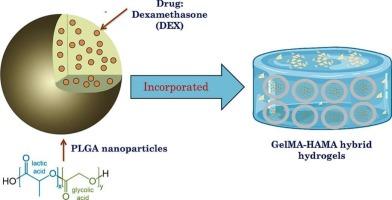Hybrid GelMA-HAMA hydrogels incorporating dexamethasone-loaded PLGA nanoparticles for controlled release and osteogenic differentiation for bone tissue regeneration
IF 6.3
2区 化学
Q1 POLYMER SCIENCE
引用次数: 0
Abstract
The development of novel approaches to bone regeneration remains a challenge in medicine. For such, the control release of biochemical factors appears key to successfully regulate the regeneration process. In this work, the characterization of methacrylated gelatin (GelMA)-hyaluronic acid (HAMA) hydrogels that incorporated dexamethasone-loaded poly(lactic-co-glycolic acid) nanoparticles (DEX-PLGA NPs) was explored as potential scaffolds for bone tissue regeneration. The DEX-PLGA NPs were synthesized and incorporated into the polymeric hydrogels to achieve a controlled and sustained release of the drug in order to ensure the progressive osteogenic differentiation of adipose-derived mesenchymal stem cells (adMSC) within the scaffold. The physicochemical properties of the NP-loaded hydrogels were not affected by the incorporation of DEX-PLGA NPs. In vitro studies demonstrated that these hybrid hydrogels are biocompatible and presented excellent cell adhesion, proliferation, and differentiation properties promoted by the sustained release of dexamethasone as observed, for example, by the alkaline phosphatase (ALP) assay, which confirmed large concentrations of phosphate ions after the first 14 days of incubation. Furthermore, Alizarin Red S staining corroborated a good mineralization, indicative of effective bone matrix formation.

混合GelMA-HAMA水凝胶,含有地塞米松负载的PLGA纳米颗粒,用于控释和成骨分化,用于骨组织再生
骨再生新方法的发展在医学上仍然是一个挑战。因此,控制生化因子的释放是成功调节再生过程的关键。在这项工作中,研究了甲基丙烯酸明胶(GelMA)-透明质酸(HAMA)水凝胶的特性,该凝胶含有负载地塞米松的聚(乳酸-羟基乙酸)纳米颗粒(DEX-PLGA NPs),作为骨组织再生的潜在支架。合成DEX-PLGA NPs并将其掺入聚合水凝胶中,以实现药物的可控和持续释放,以确保支架内脂肪源性间充质干细胞(adMSC)的进行性成骨分化。负载np的水凝胶的物理化学性质不受掺入DEX-PLGA np的影响。体外研究表明,这些混合水凝胶具有生物相容性,并表现出优异的细胞粘附、增殖和分化特性,如通过碱性磷酸酶(ALP)试验观察到的,地塞米松的持续释放促进了细胞的粘附、增殖和分化。碱性磷酸酶(ALP)试验证实,在培养的头14天后,磷酸盐离子浓度很高。此外,茜素红S染色证实了良好的矿化,表明有效的骨基质形成。
本文章由计算机程序翻译,如有差异,请以英文原文为准。
求助全文
约1分钟内获得全文
求助全文
来源期刊

European Polymer Journal
化学-高分子科学
CiteScore
9.90
自引率
10.00%
发文量
691
审稿时长
23 days
期刊介绍:
European Polymer Journal is dedicated to publishing work on fundamental and applied polymer chemistry and macromolecular materials. The journal covers all aspects of polymer synthesis, including polymerization mechanisms and chemical functional transformations, with a focus on novel polymers and the relationships between molecular structure and polymer properties. In addition, we welcome submissions on bio-based or renewable polymers, stimuli-responsive systems and polymer bio-hybrids. European Polymer Journal also publishes research on the biomedical application of polymers, including drug delivery and regenerative medicine. The main scope is covered but not limited to the following core research areas:
Polymer synthesis and functionalization
• Novel synthetic routes for polymerization, functional modification, controlled/living polymerization and precision polymers.
Stimuli-responsive polymers
• Including shape memory and self-healing polymers.
Supramolecular polymers and self-assembly
• Molecular recognition and higher order polymer structures.
Renewable and sustainable polymers
• Bio-based, biodegradable and anti-microbial polymers and polymeric bio-nanocomposites.
Polymers at interfaces and surfaces
• Chemistry and engineering of surfaces with biological relevance, including patterning, antifouling polymers and polymers for membrane applications.
Biomedical applications and nanomedicine
• Polymers for regenerative medicine, drug delivery molecular release and gene therapy
The scope of European Polymer Journal no longer includes Polymer Physics.
 求助内容:
求助内容: 应助结果提醒方式:
应助结果提醒方式:


